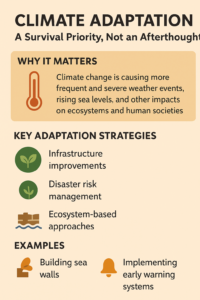Climate Adaptation Must Be Treated as a Survival Priority, Not an Afterthought
Rising seas, deadly floods, prolonged droughts, and record-breaking heatwaves are no longer predictions—they are our present. Yet, when climate change is discussed, the bulk of attention still goes to mitigation—cutting emissions—while adaptation often comes as an afterthought. This imbalance is dangerous. For vulnerable nations and communities, adaptation is not a side issue—it is a survival priority.
Overview
The central idea of climate adaptation is straightforward: even if global carbon emissions drop drastically today, climate impacts will continue for decades. Adaptation means preparing people, infrastructure, and systems to withstand those shocks. From climate-smart agriculture to flood-resistant housing, adaptation saves lives and reduces economic loss.
The real danger is not only climate change itself, but also the lack of preparedness. The 2022 Pakistan floods are a stark reminder that ignoring adaptation can erase decades of development in a matter of weeks. The world must shift from reactive disaster management to proactive adaptation.
Notes
-
Adaptation vs. Mitigation: Mitigation slows climate change; adaptation ensures survival amid its effects.
-
Practical measures: Stronger drainage systems, early warning networks, drought-resistant crops, resilient healthcare.
-
Why urgent? Climate shocks are already happening—floods in Pakistan, heatwaves in Europe, wildfires in Canada.
-
Financing gap: Less than one-fourth of climate funds go to adaptation, despite urgent needs in the Global South.
-
Cost-benefit: Every $1 spent on adaptation can save $4–10 in recovery costs.
Relevant CSS Syllabus or Subjects
-
Essay Paper: Climate change, sustainable development, global survival strategies
-
Current Affairs: Pakistan’s floods, COP summits, climate financing
-
International Relations: North-South climate divide, climate justice, adaptation funding debates
-
Environmental Science: Disaster risk management, resilience frameworks
-
Pakistan Affairs: Pakistan’s vulnerability, adaptation policies, food and water security
Notes for Beginners
Think of climate change like an unstoppable storm. Mitigation is about trying to calm the storm, but adaptation is about building strong shelters before it hits.
-
Pakistan needs homes that can survive flooding.
-
Farmers need training and tools to handle unpredictable rain.
-
Hospitals must prepare for heat-related illnesses.
For exam prep, remember: mitigation is long-term; adaptation is immediate survival.
Facts and Figures
-
The 2022 Pakistan floods affected 33 million people and caused losses worth over $30 billion.
-
The UNEP estimates developing countries will need $300 billion per year by 2030 for adaptation.
-
Only about 20% of global climate finance is directed towards adaptation.
-
Without stronger adaptation, up to 1.2 billion people could be displaced by climate impacts by 2050.
-
Studies show adaptation investment saves 4–10 times more in avoided damages.
Wrap-Up
Climate adaptation is not an optional policy add-on. For billions across the globe, it is the line between survival and catastrophe. The floods in Pakistan, wildfires in Europe, and droughts in Africa all point to one reality: adaptation cannot be delayed.
The blog’s message is clear—climate adaptation must move from the margins to the center of global policy. Mitigation tackles the cause, but adaptation protects lives here and now. Ignoring it is no longer an option.


